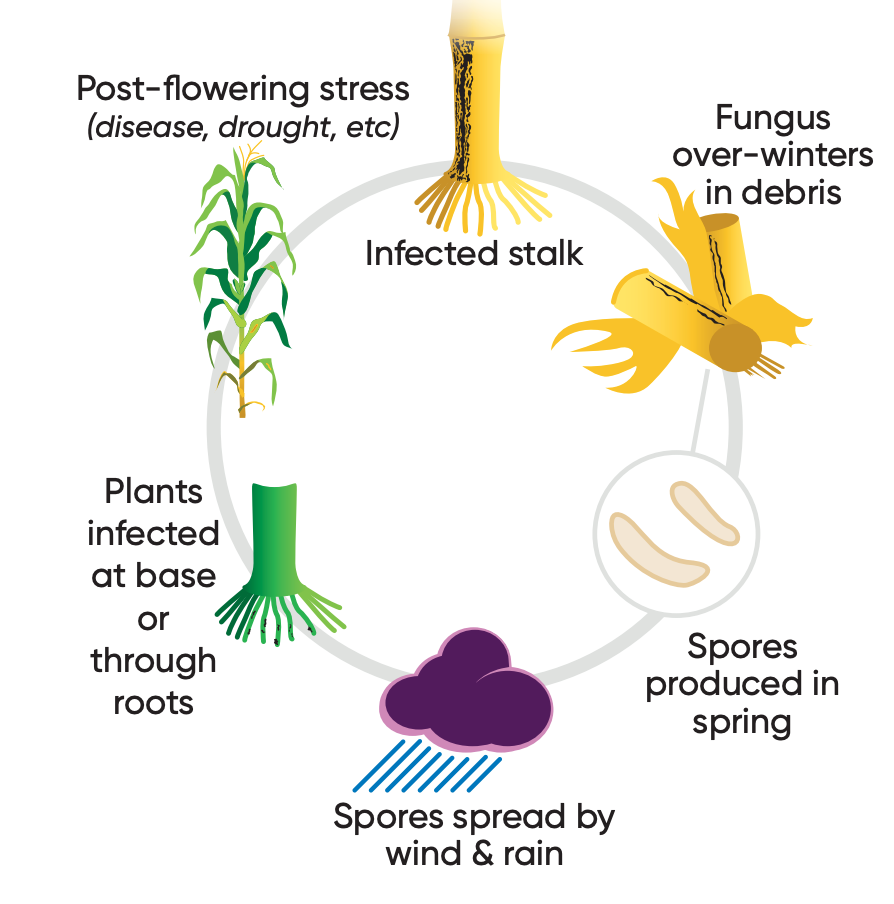Anthracnose leaf blight is a fungal pathogen that poses a significant threat to corn, grain sorghum and small grain growers across the United States. In fact, studies show severe levels of anthracnose in fields can cause up to 80% lodging and 40% yield loss.1
- Common name: Anthracnose leaf blight
- Scientific name: Colletotrichum graminicola
- Symptoms: Upon infection, small, round to irregular-shaped, water-soaked spots appear. These spots later turn yellow and then brown with reddish-brown borders.
- The leaf spots may enlarge to ½ inch long and join together.
- In severe cases, the leaf tips or entire leaves may turn yellow.
- Conditions for development: The pathogen overwinters in diseased leaves and stalks on the field’s surface. During warm, rainy spring conditions, the infected residue produces spores that can infect seedling roots and foliage. Spores are spread through wind and rain, with infection thriving in warm temperatures (70 F to 80 F) and high humidity.
Fast Facts on Anthracnose Leaf Blight:
- Anthracnose is common early in the season where diseased crop residue is left on the soil. Infection develops when spores are splashed onto seedling plants by rain.
- Symptoms begin on lower corn leaves early in the growing season and then develop on the upper leaves late in the season. Lesions enlarge up to 5 to 6 inches long and may join together to infect the entire leaf.2
- Anthracnose can be found on all parts of the corn plant throughout the growing season. Although the pathogen is common in seedlings, plants in the ear-fill stage often become susceptible to the top dieback and/or stalk phase of the disease.
- Top dieback caused by the anthracnose pathogen is characterized by yellowed, purple or brown flag leaves on plants scattered throughout the field. When the leaf sheaths are peeled back at the top of affected plants, shiny black lesions can be observed on the outside of the stalk.1
- Because anthracnose has both a leaf and stalk phase in corn, the infection can spread from the leaves to stalk. The stalk also may be infected through the roots or base of the plant. The image below illustrates the disease life cycle.

Control Tips:
The most substantial crop losses from anthracnose are often a result of stalk rot.1 To best manage this pathogen, it is critical growers proactively scout and harvest fields according to current crop conditions. Additionally, customers can further protect their yield from diseases like anthracnose by implementing these management tips:
- Plant well-adapted, disease- and stress-resistant hybrids.
- Practice balanced soil fertility.
- Reduce crop stress through plant populations, irrigation, soil fertility management and weed control.
- Manage corn residue.
- Consider fungicide applications for effective anthracnose prevention and control.
- Aproach® Prima fungicide is rainfast within one hour and provides residual activity for up to three weeks. With two modes of action, it is both preventive and curative to fight tough diseases like anthracnose.
1Kleczewski, N. 2014. Anthracnose Leaf Blight and Stalk Rot of Corn.
https://www.udel.edu/academics/colleges/canr/cooperative-extension/fact-sheets/anthracnose-leaf-blight-and-stalk-rot-of-corn/
2Malvik, D. 2018. Anthracnose Leaf Blight on Corn.
https://extension.umn.edu/corn-pest-management/anthracnose-leaf-blight-corn#:~:text=and%20top%20dieback.-,Symptoms,leaves%20late%20in%20the%20season.
Aproach® Prima is not registered for sale or use in all states. Contact your state pesticide regulatory agency to determine if a product is registered for sale or use in your state. Always read and follow label directions.

